In a recent survey we conducted, we discovered out that 45% of small and medium-sized businesses (SMBs) do not measure the ROI (return on investment) on their digital marketing spend. At a time when 70% of SMBs are increasing their spending on online marketing, it seems that there is very little attention being paid to ROI. Most importantly, as the trend towards online marketing and e-commerce continues, small businesses need a digital presence or will be left behind. But, how do you ensure your money works for you?
Simple, digital marketing makes it easy to measure ROI!
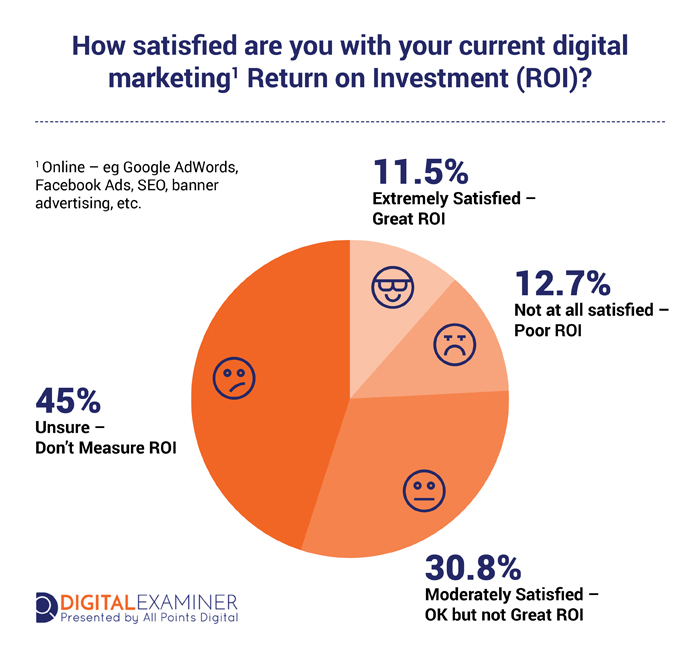
Using Google Surveys, we asked 1,000 SMB owners the question “How satisfied are you with your current digital marketing (online – eg Google AdWords, Facebook Ads, SEO, banner advertising, etc.) ROI?”
The results were somewhat surprising:
- 11.5% of SMB owners are extremely satisfied with their ROI.
- 30.8% of SMB owners are moderately satisfied with their ROI.
- 45% do not measure ROI.
- 12.8% answered that their ROI is poor.
With almost half of all SMBs leaving the success of their digital marketing efforts to chance, we decided to put together a comprehensive guide on how SMBs can measure their digital marketing ROI. Our guide will cover everything you need to about SMB digital marketing ROI including:
- The Basics of Digital Marketing ROI.
- Common mistakes SMBs make when trying to measure ROI.
- How to setup conversion tracking for your paid marketing campaigns.
- How to track organic conversions with Google Analytics.
- Call tracking best practices.
The Basics of Digital Marketing ROI
Digital marketing can be a pretty significant investment for SMBs. However, unless you measure the ROI of your digital marketing spend, then you have no idea how to measure or evaluate the effectiveness of your investment. Unfortunately, as our study indicates a full 45% of SMBs are leaving the success of the digital marketing to chance.
Nearly a full century has passed since marketing and advertising pioneer John Wanamaker stated that “Half the money I spend on advertising is wasted; the trouble is, I don’t know which half.” For 45% of SMB owners out there, it seems that not much has really changed. That being said, measuring digital marketing ROI can be quite challenging when you consider that SMBs are now using an average of 7.8 different channels to promote themselves – that figure does include both traditional and digital marketing activities but still reflects the increasing complexity of SMB marketing.
The main types of digital marketing activities SMBs use include:
-
Search Engine Optimization (SEO)
It is rare that you will come across a business that does not have some sort of SEO strategy. SEO – as the name suggests – is all about increasing your website rankings in organic search listings for terms related to your product or service. An important part of SEO for many SMBs is local search marketing which focuses on getting into Google’s local search results when people search for a service near to them.
-
Pay Per Click Advertising (PPC)
PPC ads are those ads that Google and other search engines feature alongside their search results. Here is an example.
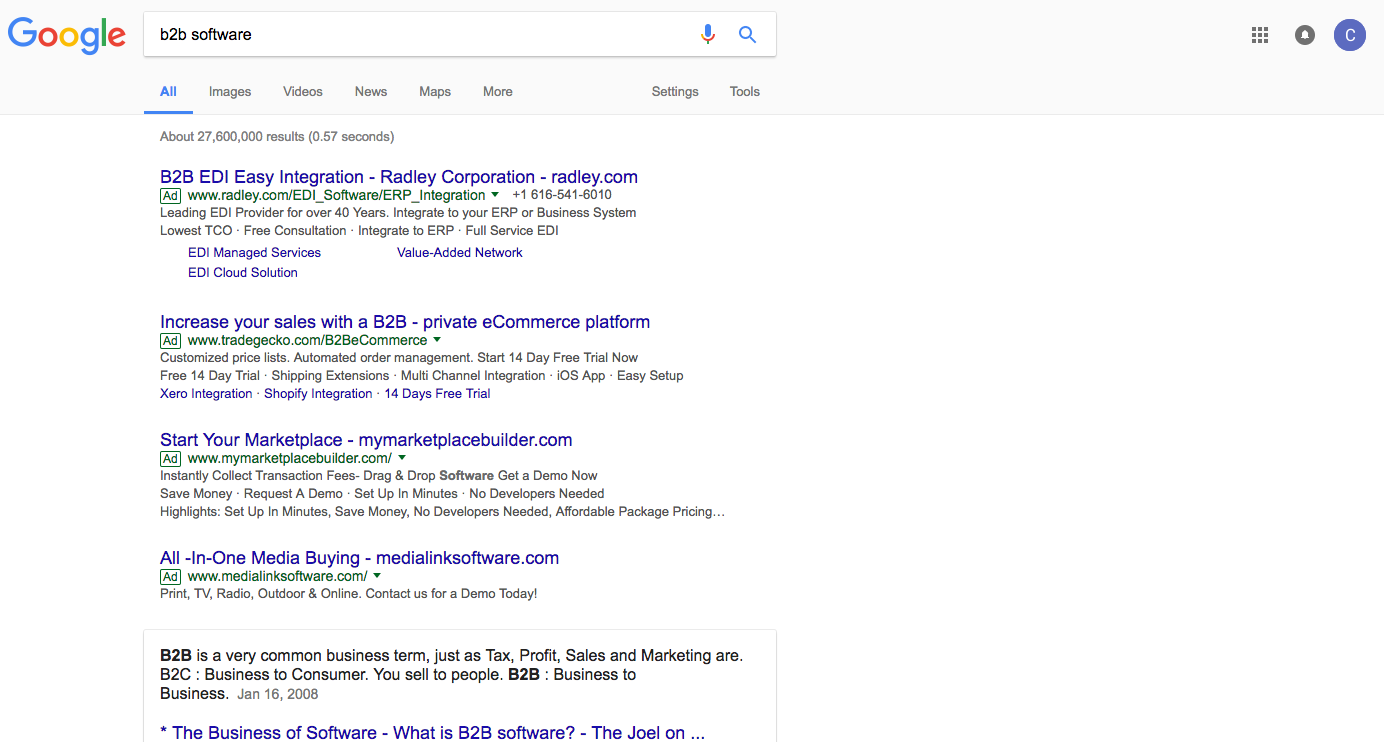
With Google the way PPC works is companies bid on keyword search terms related to their business. When a user searches for said term, Google will list the highest bidder at the top of the SERP (search engine results page). Companies are then charged on a PPC basis.
-
Social Media
Social media hit the scene a few years ago, but still remains a significant presence in online marketing for SMBs. However, as these platforms evolved, organic social posts lack generating a lot of engagement for small businesses with limited followings. But, paid social, where posts are promoted to appear in target customer newsfeeds still generate engagement. Additionally, SMBs can also leverage more traditional display ads on platforms like Facebook which users can see on a sidebar. Fortunately, most SMBs still use organic social media marketing to build and interact with a community by sharing posts and conversing with followers.
-
Content Marketing
Content marketing is at the core of all SMB digital marketing. The basic concept is that companies publish high-quality content on their site that attracts visitors to their site – generating new leads and customers in the process.
-
Email Marketing
Research shows that of all marketing activities email marketing delivers the best ROI. Many SMBs use email marketing as a low-cost method of staying in touch with their customers and potential customers. Usually, companies will advertise an email opt-in on their site and build their database that way. As new offers and product updates arise, relevant segments of the database will be sent emails.
With so many different digital channels to reach potential customers, it is easy to see how it can be difficult from SMBs to measure their ROI. However, without tracking digital marketing ROI, it is hard to optimize your strategy and the likelihood is that you are not getting as much value out of your digital marketing spend as you should be.
Common mistakes SMBs make when trying to measure ROI
When it comes to measuring marketing ROI, there are a number of common pitfalls to avoid.
-
No Conversion Tracking
This mistake is one that is easily remedied. Tracking website conversions is really a basic starting point for measuring ROI and it doesn’t have to be a major time investment. Later in the guide we will lay out how to setup conversion tracking for paid services like Google Ads and Facebook Ads, and also how to track organic conversions with Google Analytics.
-
The Value of a Lead is Unknown
Too many SMBs do not know the value of a lead. Again, figuring out the value of one lead is quite straightforward. To learn the value of a lead at your company simply use this formula:
Lead Value = Average Selling Price / Number of Leads
All you have to do is calculate your average selling price and the number of leads it takes you to make one sale. Depending on your sales model and the quality of leads you generate, you might want to tweak the formula to suit yourself. However, it is still a fairly basic concept and can easily be calculated.
Knowing the value of a lead is vital and will inform your digital marketing strategy. Without this information, you are really taking pot shots in the dark. With it, you can figure out how much you should devote to PPC campaigns etc.
-
Not Measuring Lifetime Value (LTV) of a Conversion
Figuring out the value of a lead is a good start for measuring digital marketing ROI, however, if you really want to optimize your marketing campaigns, you should think about segmenting your customer database according to LTV. All of your customers are different and by figuring out LTV, you can pinpoint where the customers with the highest LTV came from and focus your digital marketing efforts on those areas.
LTV is defined by the Marketing Accountability Standards Board as ”the present value of the future cash flows attributed to the customer during the entire relationship with the company.” There are a number of different methods to calculate LTV. The most basic calculation is:
Average customer value per year (or month) x Average customer lifespan
Depending on your business model, you might want to incorporate values for customer retention rate, profit margin per customer, rate of discount, and average gross margin per customer lifespan.
The thing to remember about LTV is it is a predictive metric so you will never be able to measure with 100% certainty. What you want to be able to do is calculate LTV as accurately as possible – using all the relevant inputs – to help you make smart business decisions. In terms of digital marketing ROI, if, for instance, you can see that the LTV for organic leads is twice as high as the LTV for PPC leads, you will be able to figure out where to focus your digital marketing efforts in future.
Setup conversion tracking for your paid marketing campaigns
Conversion tracking refers to the successful completion by a website user of a predefined action or goal such as a sign-up form or a purchase. For e-commerce businesses having a killer digital marketing strategy is essential. SMBs use conversion tracking to measure the performance of their digital marketing activities. Intimidating as it may sound, conversion tracking can be relatively straightforward. It usually involves little more than pasting a line of code in the footer of a thank you page.
How to Setup Google AdWords Conversion Tracking
AdWords is the most popular form of digital advertising by some distance. Setting up conversion tracking here is really simple.
- Log into your AdWords account and click on the “tools” tab and choose “conversions”.
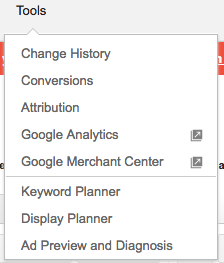
- Choose “Add Conversion”
- Select the source of your conversion.
- For this example, we’ll choose Website.
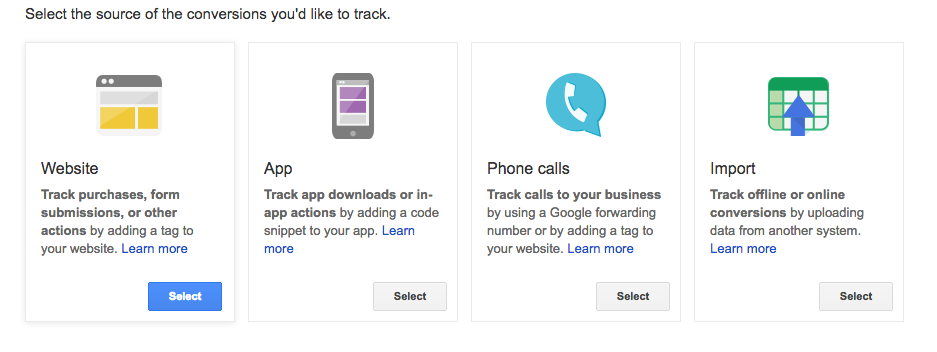
- Next, you need to fill in some details on the type of conversion including name, value, how you would like to count your conversions, the length of the conversion window, category, and the attribution model.
- You can then choose whether you would like to track conversions on a page load or a page click. Page load refers to the page the customer reaches after they have been converted, sometimes referred to as a “thank you page”. Page click is the button the user clicks to complete the goal, an example would be a “sign up” button.
- Choosing “page load” makes it easier to install the automatically generated tracking code. To start tracking conversions all you have to do is paste the code between the <body></body> tags on your thank you page.
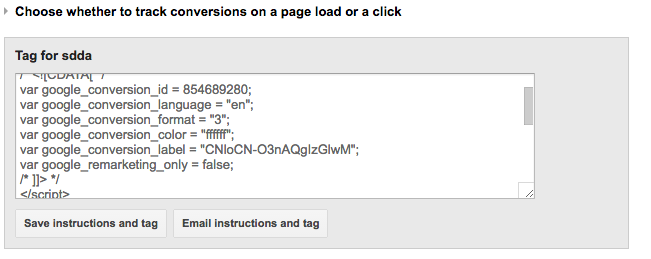
If you are running more than one Ads campaign, you will need to repeat the steps we have laid out for each. Once you have completed this step, you are all set and ready to go with Ads conversion tracking. The amount of time this setup will take depends on the number of campaigns you are running, but, realistically, it is a very small time investment that – for most SMBs – can be completed in less than an hour or two.
Review Conversion Tracking!
All you need to do now is take a step back and let Ads gather the data you need to figure out ROI and give you the information you need to make more informed marketing decisions. Taking this step comes with many benefits.
- See what’s working: Ads conversion tracking lets you see which landing pages, campaigns, keywords, and ads are giving you the best ROI.
- Test, test, test: With Ads conversion tracking implemented, you can start to test things like landing page copy, button color, and other variables to drive up your conversions.
- Eliminate wastage: You now have visibility into how each ad is performing. If an ad is not showing a satisfactory ROI, simply cut it from your spend.
How to Setup Conversion Tracking for Facebook Ads
Tracking the ROI of your Facebook Ads is also done through the installation of a pixel – the piece of code you add to your website that tracks user actions.
- To begin with, navigate to the Facebook Pixel tab in Ads Manager and choose “create a pixel”.
- Enter the name of your pixel and choose “create”.
- The Facebook Pixel contains two components. First, the base code which tracks website activity and provides a baseline for events. Second, the event code which tracks specific user actions (such as viewing content or adding something to their cart).
- To install the base code, navigate to the Pixels page in Ads Manager and choose “view code”.
- Copy and paste the code between the <head> tags on your site.
- To add the event code for the events that matter to you, go to the Facebook Pixel tab in Ads Manager.
- There you will see a corresponding line of code for each of the 9 events Facebook can track. Simply copy and paste the code for the action you want to track on relevant pages on your site.
- You will have to add the event code and base code separately and the end result will look like this.
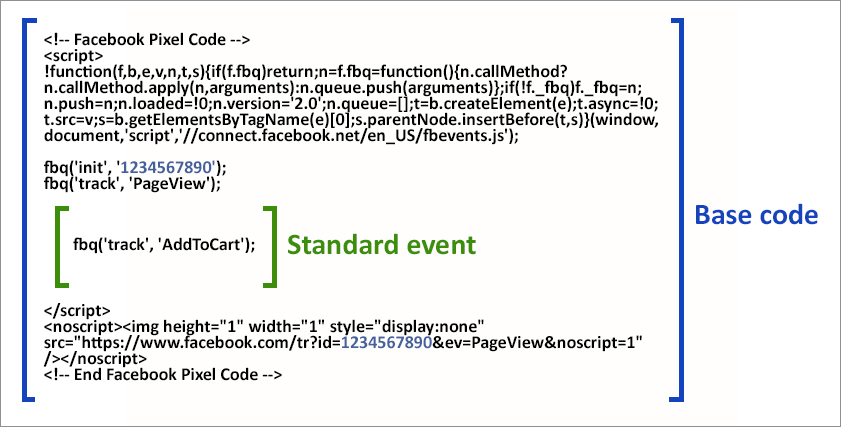
While there is an extra step here because of the way Facebook separates event and base codes, it is not that much extra work and will give you visibility into the ROI of your Facebook ad campaigns. For more information on Facebook Ad tracking, check out this really helpful post by Social Media Examiner.
How to Setup Conversion Tracking for Twitter Ads
The process for setting up conversion tracking for your Twitter ads is quite similar to Facebook and AdWords.
- In Twitter Ads, select “Tools”, then “Conversion Tracking”.
- Choose “Create a New Website Tag”.
- Create a name and choose the conversion type.
- Choose whether or not you want to “create a tailored audience”. By choosing yes, users who engage with your ad will be added to an “audience” which you can target in future campaigns.
- Set the length of the conversion window.
- Click save and generate the code snippet.
- Place the snippet into your website’s HTML.
How to Setup LinkedIn Sponsored Posts and Text Ads Tracking
It is also really simple to get setup LinkedIn ads tracking. All you need to do is:
- Log into Campaign Manager
- Click “Tags”, then “New” to create a new tag.
- Choose “LinkedIn Insights” from the “Tag Type” drop down menu.
- Add the LinkedIn Insight tag to your website’s HTML.
- Create a conversion action and add it to the campaign.
- Measure the performance and ROI of your ads in LinkedIn Analytics.
Tracking Organic Conversions with Google Analytics
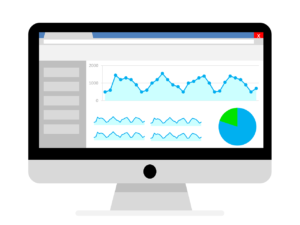 While we have laid out how you can measure the ROI of your paid campaigns, SEO and organic search marketing are also vital components of SMB digital marketing. When it comes to measuring the impact of your website Google Analytics (GA) is the most powerful weapon in your arsenal. Available for free, GA comes with advanced reporting and drill down options that can provide you with invaluable insights into the performance of each page on your site.
While we have laid out how you can measure the ROI of your paid campaigns, SEO and organic search marketing are also vital components of SMB digital marketing. When it comes to measuring the impact of your website Google Analytics (GA) is the most powerful weapon in your arsenal. Available for free, GA comes with advanced reporting and drill down options that can provide you with invaluable insights into the performance of each page on your site.
How to Setup GA Conversion Tracking
The first step in getting set up to track organic conversions is making sure GA is correctly installed on your site.
- In your Google account, choose “Google Analytics” and sign up.
- There you will need to choose whether you want to install Google Analytics on your website or a mobile app. You will also need to fill in basic details like website name, URL etc.
- Once you have filled in your details, choose “Get Tracking Code”.
- Upon agreeing to Google’s terms and conditions, Google provides the tracking code. The code requires installation on every page of your website.
- If you have a WordPress site, adding this code is relatively straightforward. The most popular method is through an easy to use plugin called MonsterInsights (formerly known as Google Analytics for WordPress by Yoast). If your SMB uses Shopify, then installation is even easier, all you need to do is paste the code into the Google Analytics section in your “online store” settings. Similarly, it is really easy to set GA up on Squarespace sites. You just need to select “Advanced” then “External Services” from your settings menu. Then all you need to do is paste the tracking code in the Google Analytics Account Number field. For websites based on other platforms, a quick Google search will get you any number of guides. TemplateMonster, for instance, provide a useful how-to guide on installing GA on Drupal.
Establish a Goal
The second part of setting up organic goal conversions involves setting up a “New Goal” in GA, but first, you need to make sure that you have some “thank you” or confirmation pages set up on your website. If you are tracking purchases or form completions on your site, the thank you page is the page the user sees after they have completed the conversion. The URLs for your thank you pages should have a common path like /thank-you.
With your thank you pages ready, you can set up your new goal in GA.
- After entering a goal description you can set the destination of the goal by choosing “begins with” and entering the common URL path your thank you pages has – in the example above we used /thank-you.
- After that you can choose to attribute a dollar value to the conversion.
- Choose “Create Goal” and you will be up and running with organic conversion tracking in GA.
- To see how your goals are performing you can check back into GA after a week or so and select “Acquisition”, then “All Traffic”, and then “Channels”.
Now you can see the performance of each of your traffic sources including organic, referral, direct, and paid. GA will show the number of users, bounce rate, average session duration, and goal conversion rate of each channel.
If you want to go deeper into your organic traffic, there are any number of reports you can run to help you do so.
Call Tracking Best Practices
One of the easiest ways for SMBs to measure their digital marketing campaigns is to use call tracking numbers. Call tracking numbers are custom phone numbers that are forwarded straight through to the actual business phone number. However, call tracking numbers enable SMBs to track the number of leads they generate from a particular marketing or advertising campaign.
There are a number of other benefits too including keyword tracking. For example, a prospect calls up a number associated with a paid ad. As a result, the tracking captures the exact search term (keyword). Plus, with call tracking, you can also track the success of your campaigns. The leading call tracking software solutions will provide you with an analytics dashboard which will show you exactly how many calls each of your marketing campaigns are generating.
Using call tracking software is a great way to track your digital marketing ROI and can also help you to maintain compliance by monitoring employee calls for risky and non-compliant language. Elsewhere, call tracking software can help you get hugely valuable insights into how your top performers are conducting their phone conversions. The leaders in the call tracking software space are CallRail, Call Box, Twilio, CallMiner, and CallFire.
Small Business Marketing ROI Impact
As we have shown, the benefits of measuring your digital marketing ROI far outweigh any potential drawbacks. Depending on the type of digital marketing campaigns you run at your SMB, setting up conversion tracking might only take a couple of hours. Measuring ROI provides the foundation for making more informed marketing decisions. Ultimately, better data helps make better decisions, which generates increased revenue.





